BACK TO HOME
Sugarbush Management
- 24 STORIES
- PAGE: 1 2 3
- SHOW ALL

Caterpillars are back this summer, and hungry
Paul Post | June 21, 2022
WEST CHAZY, N.Y.—They're back and they're hungry.
A widespread invasion of Lymantria dispar, previously called gypsy moths—now known as the more politically correct spongy moth—is expected to be larger than last year's infestation that impacted an area from Michigan to northern New York and Vermont.
Tiny caterpillars emerge in spring and devour many types of hardwood tree leaves and some evergreens, completely defoliating forests where outbreaks are most severe.
"Leaves are usually eaten soon enough in the year that trees will put out a new flush of leaves, but this takes energy away from the trees' stored pool of energy, the same energy source (sugars) we are pulling from during the maple season," said Adam Wild, director of Cornell University's Uihlein Maple Research Center in Lake Placid, N.Y.
"One year of defoliation will more than likely not kill the tree, but if the tree is already stressed it's going to add to the tree's demise. It could also impact our future maple production seasons," Wild said. [ MORE ]
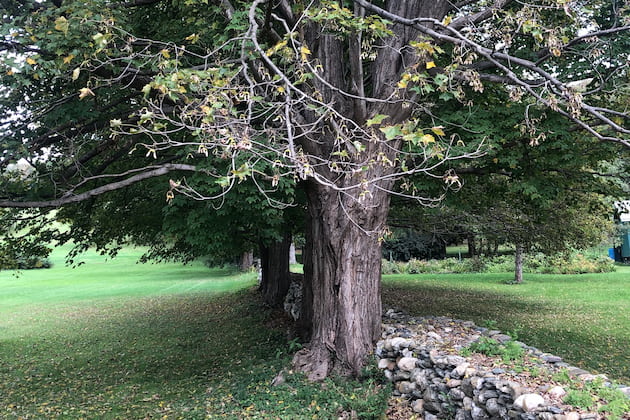
Trees looking terrible and probably infected with anthracnose
Peter Gregg | September 22, 2021
STILLWATER, N.Y.—It’s not your imagination, the trees look terrible.
Trees across the Maple Belt have a curled, brownish look with dropping leaves and premature color changes, with some turning color in the middle of August.
“I don't believe I have observed sugar maples transition in this manner and in the quantity we are currently observing,” said Linda White, a ranger with the National Park Service in Stillwater, N.Y. who has been observing trees for the USA National Phenology Network for 25 years.
White said on Sept. 16 that the trees were the worst she’d ever seen them.
Sugarmakers have been noticing a decline in trees since the spring.
Experts are blaming most of the problem on Maple anthracnose, a fungal disease that won't kill the tree but sure makes them unsightly. [ MORE ]

Earthworms could be killing the maples of the Upper Midwest
Jesse Hirsch | September 13, 2021
HOUGHTON, Mich.—Worms could be killing maples.
They're the darlings of the gardening world. But a university study suggests we should rethink their role in soil.
In recent years, earthworms have taken something of a star turn. While not as lauded as the beleaguered honeybee, the little wrigglers are largely viewed as a crucial building block to sustainable agriculture.
But if you consider yourself a superfan, we’ve got some bad news: Worms are causing trouble in the forest.
A study from Michigan Technological University revealed how earthworms are linked to a “dieback” in the Upper Midwest’s sugar maple trees.
The study resulted from a what foresters observed as a noticable decline in Michigan’s prized sugar maples, renowned for their foliage, lumber and (of course) sugary sap.
Reports had been coming in from local foresters that many maples were looking quite unhealthy, with naked limbs and minimal new growth.
In looking for causes, lead researcher Dr. Tara Bal said her team wasn’t initially focused on earthworms. [ MORE ]

Maple-eating Spotted Lanternfly spotted in Vermont
Peter A Gregg | September 7, 2021
MONTPELIER, Vt.—A maple-eating invasive insect from China has been found in Vermont.
The Vermont Agency of Agriculture, Food and Markets (VAAFM) was alerted in August that a live ‘Spotted Lanternfly’ was captured at a business in Rutland while unloading a truck originating from a state known to have laternfly infestations.
The business owners suspected the bugs were odd and brought them to agriculutre officials at the Forestry Building at the Rutland State Fair on August 17.
Sugarmakers have been on the lookout for the pest since it was first discovered in Pennsylvania in 2014.
The pest is known to attack maple trees as well as many other agricultural fruit crops such as grape, apple, cherry and peach. [ MORE ]
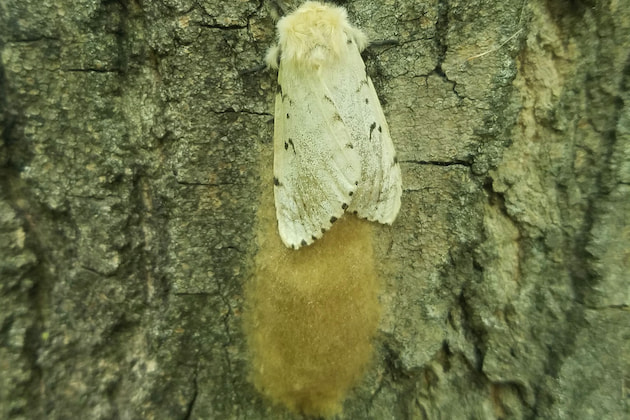
Producers are urged to check for Gypsy moth eggs this summer
Peter Gregg | July 16, 2021
ALBANY, N.Y.—This summer look for egg masses.
Officials are encouraging sugarmakers to check trees and outbuildings for egg masses of the Gypsy moth, which had huge outbreaks throughout the Maple Belt this spring.
The egg masses are found usually on the trunk of the tree and underside of larger branches, according to Adam Wild of the Cornell Maple Program in Lake Placid, N.Y.
"They can be close to the ground or all the way up the trunk," Wild said.
Some producers were seeing egg masses on mainline tubing.
The egg masses are larger and can typically be seen from the ground. Binoculars can also help. [ MORE ]
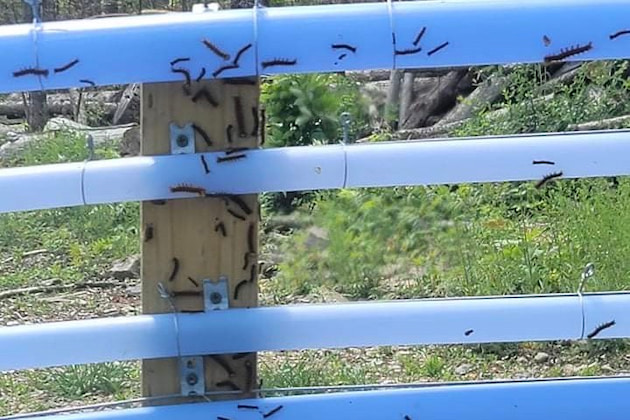
'Biblical' infestation of Gypsy moth caterpillars are attacking sugarbushes in the Northeast
Peter Gregg | June 11, 2021
WEST CHAZY, N.Y.—Gypsy moth caterpillars are attacking sugarbushes.
“It is truly biblical in proportion with larvae crawling everywhere, dropped on you from above and even eating foliage from hay in the fields,” said Laura Trudeau, one of the operators at Parker Family Maple in West Chazy, N.Y. where with husband Mike Parker, upwards of 100,000 trees are tapped.
Trudeau said the farm spent $47,000 to spray their sugarbush with Bacillus thuringiensis, called "Bt,” a natural insecticide that is the only approved spray for use in sugarbushes.
[ MORE ]

Experts say leasing 5,000 taps or more is the best option to make money in this business
Paul Post | May 14, 2021

Think like a tree. Get to know your sap.
Paul Post | December 15, 2020
FRANKLIN, W.V.—Get to know your sap.
“We’re going to try to think like a tree," said industry expert Michael Rechlin, Ph.D. of Future Generations University.
During a recent webinar, The Science Behind the Sweetness of Sap Flow, Rechlin explained the hows and whys of the annual miracle of sap flow.
"We’re going to try to figure out from a tree's perspective why that sap drips out of a tree,” he said.
His talk covered evolutionary biology, chemistry, anatomy, tree physiology, physics and biology.
The sap flow process is the result of trees response over many eons to cold weather, specifically long, hard winters.
“Life originated in the tropics and as trees, like people and animals, moved north they had to find solutions to the problem of winter,” Rechlin said. [ MORE ]

Caterpillars have retreated Vermont
Peter Gregg | July 28, 2020
MORRISVILLE, Vt.—Infestations of Forest Tent Caterpillar in Vermont have been largely non-existent this summer, state officials say.
"It's pretty quiet on the caterpillar front in Vermont,” said Mark Isselhardt of UVM Extension, who has been monitoring the pest on behalf of the maple industry for the past several years.
Issellhardt says the numbers have crashed due to natural controls like parasitic "friendly flies," viruses and birds.
The caterpillars are a naturally occurring pest that typically defoliate trees over the course of a three year cycle during an outbreak. [ MORE ]
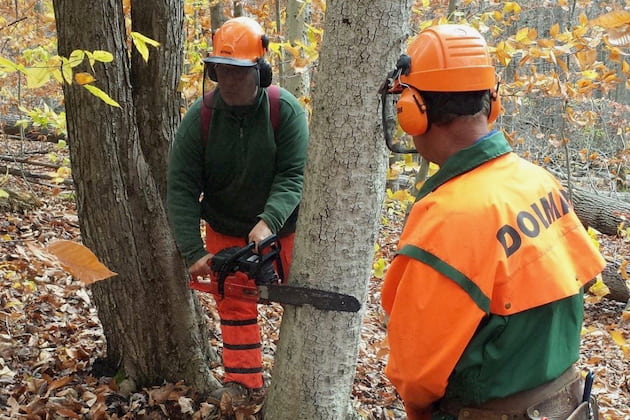
What to do about the dead ash in your woods
Peter Smallidge, NYS Extension Forester and Director, Arnot Teaching and Research Forest | June 22, 2020
ITHACA, N.Y.—The emerald ash borer (EAB, Agrilus planipennis) will have significant impacts on eastern hardwood forests.
In many areas the impact has happened.
Unfortunately, all of the mature ash are likely to die once EAB establishes and spreads in a woodlot.
Current research and corresponding field trials are evaluating the efficacy of parasitoid wasps and other biocontrol agents, but their greatest impact is likely to offer hope for ash seedlings and saplings.
More information about the EAB biocontrol program is available at http://www.emeraldashborer.info/biocontrol.php.
[ MORE ]


Study shows declining winter snowpack is hurting the sugar maple
Peter Gregg | February 13, 2019
NEW YORK—Despite a steady campaign of snowstorms this winter, the decades-long trend of declining snowpack is slowing down tree growth, scientists say.
A loss of snowpack, and in turn a deeper frost layer, dramatically reduces the ability of the sugar maple to take up water and nutrients through frost damaged roots, according to researchers.
“The experiments we conducted suggest snowpack declines result in more severe soil freezing that damages and kills tree roots, increases losses of nutrients from the forest and significantly reduces growth of the iconic sugar maple,” said Andrew Reinmann, PhD, Assistant Professor, Environmental Sciences Initiative, CUNY Advanced Science Research Center at Hunter College in New York City. [ MORE ]

Buckthorn management in the sugarbush
Peter Smallidge, Cornell University | August 24, 2018
Glossy buckthorn (Frangula alnus) and European buckthorn (Rhamnus cathartica) are common and can aggravate many ownership objectives. A variety of chemical and mechanical (i.e., organic) methods are available for the sugarmaker to control these species.
The buckthorns originated in Europe, northern Africa and western Asia. Their history of introduction into the US is poorly recorded, but many other examples of species that have become interfering were introduced in the middle 1800’s.
Glossy buckthorn was formerly known as Rhamnus frangula and is different but looks similar to the native alder-leaved buckthorn (Rhamnus alnifolia). Glossy buckthorn is a small shrub that is most common on moist soils, often near wetlands.
As with other interfering species, the interfering buckthorn species can dominate a site resulting in complicated access, reduced success with forest regeneration, and a reduction in plant species diversity. [ MORE ]

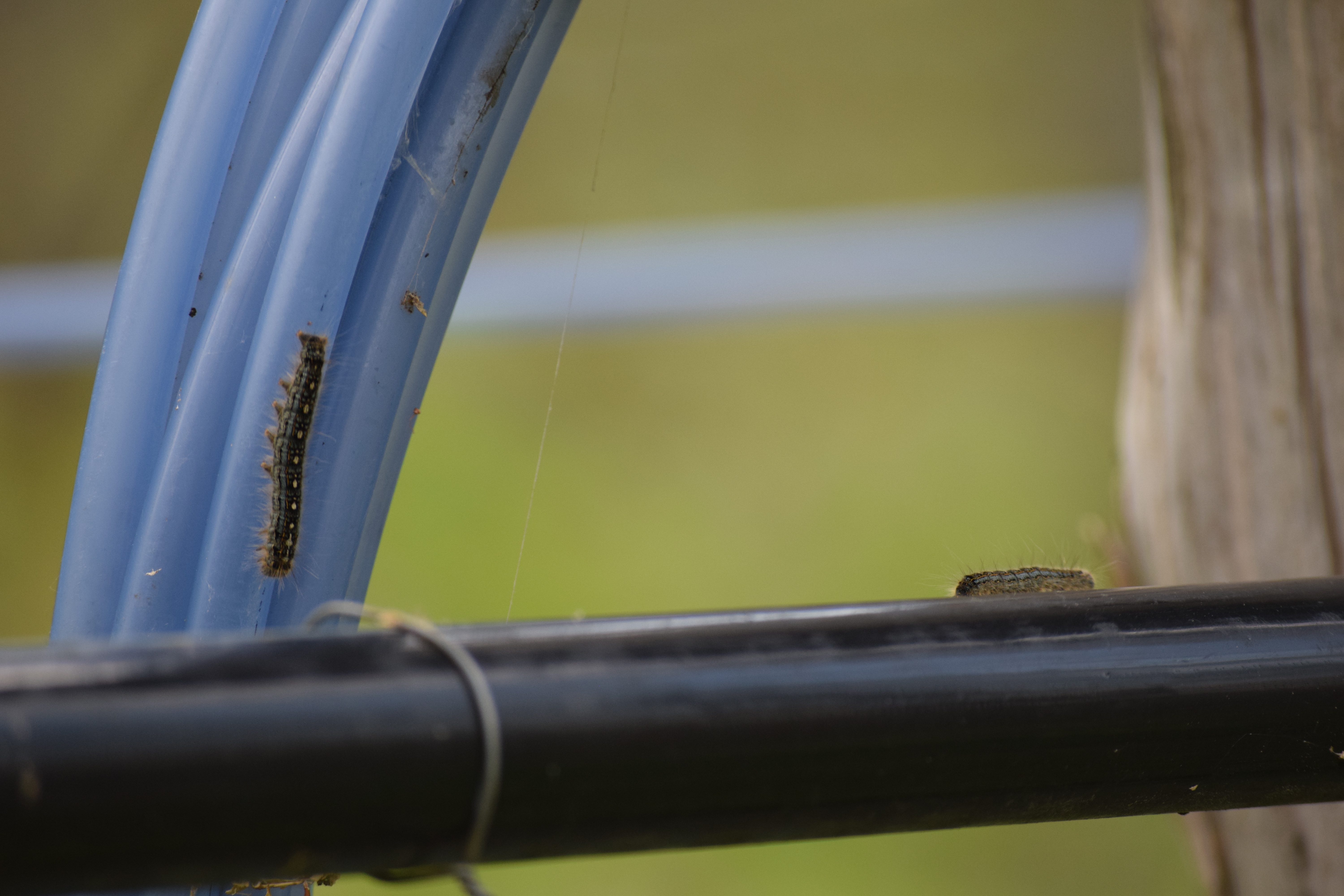
Forest tent caterpillars back on the crawl in Vermont
Leon Thompson | June 20, 2018
BURLINGTON, Vt.—Just how many acres of maple trees will the forest tent caterpillar affect in Vermont this year — and possibly next?
State officials and maple industry experts in the Green Mountain State are using the remainder of this year to find an answer to that question.
By the end of July, the state will have sketched a map of Vermont that will help delineate specific areas of defoliation caused by the forest tent caterpillar this year.
Then, over this coming winter, The Vermont Department of Forest, Parks and Recreation will work with the Civil Air Patrol to conduct an arial egg mass survey of the entire state, to prepare for 2019.
[ MORE ]

Wriggling little pests have something to chew on
Paul Post | Oct. 3, 2017
David Smart is used to seeing the sun shine down through treetops when sap starts flowing in his northern New York sugarbush. In July, there’s normally have heavy green canopy overhead.
But not this year as an unprecedented infestation of forest tent caterpillars has stripped trees of their leaves, creating a scene that looks more like early spring instead of mid-summer. Hundreds of acres throughout the North Country have been affected by the wriggling little pests. [ MORE ]

Going solar: Powering the sugarhouse with the sun
Deborah Jeanne Sergeant | July 2017
According to the Governor’s office, solar use in New York grew 300 percent from 2011 to 2014. Gov. Andrew Cuomo’s Reforming the Energy Vision program plans to spend $1 billion on solar, which can help ag operators better afford to install solar panels.
Additional solar growth in New York State could come from another element in the REV program, a proposed $5 billion Clean Energy Fund, which would put investments into play over the next ten years across four portfolios: Market Development, Innovation and Research, NY Green Bank and NY-Sun.
Though this statistic includes numerous agricultural operations, many of those are dairies. Few of them are maple sugar producers. [ MORE ]

Opinion: How is sugaring like dairy farming?
David Folino | May 2017
I live and sugar in Addison County Vermont. In my area there are plenty of dairy farmers and plenty of sugar makers. I have quite a few friends who are dairy farmers and I am familiar with the business. I’ve watched the price of milk fluctuate dramatically over the past four decades, and during that time, I’ve watched dairy farmers use a strategy which seemed counterproductive and doomed to failure. [ MORE ]

Expert provides tips on sugarbush appraisal
Paul Post | March 2017
BRATTLEBORO, VT. — Understanding the ins and outs of property appraisals can maple producers make well-informed, wise decisions before purchasing sugarbush.
Whether the site has an existing operation or its virgin woodland, Bob Guay of Yankee Farm Credit, explained the many things involved with an appraisal and the help that’s available, during the Jan. 21. Winter Maple Conference in Brattleboro, Vt. [ MORE ]

Company can map your sugarbush with a drone
Peter Gregg | Nov. 2016
The future keeps catching up to the maple industry.
One of Quebec’s leading technology innovators is offering drone services to sugarmakers, helping producers map out their sugarbush with real arial photos and 3D graphic images of sugarhouses. [ MORE ]

Enhancing tree regeneration following forest harvesting
Peter Smallidge | September 2016
Many wooded properties are harvested prior to the sale of the land. Unfortunately, these harvest may not give adequate attention to the multi-year process that is necessary to ensure the woods are successfully regenerated following the removal of numerous canopy dominate trees. [ MORE ]

Enhancing tree regeneration
Peter Smallidge | September 2016
Many wooded properties are harvested prior to the sale of the land. Unfortunately, these harvest may not give adequate attention to the multi-year process that is necessary to ensure the woods are successfully regenerated following the removal of numerous canopy dominate trees. [ MORE ]
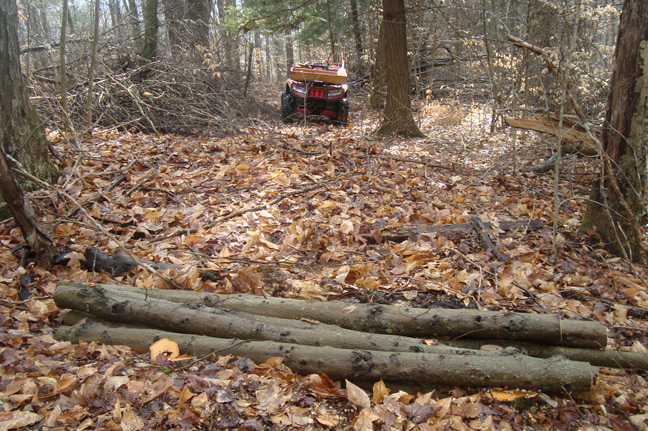
Logs to Lumber
Peter Smallidge, NYS Extension | Aug. 18, 2016
A common feature of managed woods, and an aspect that has made them popular among farmers, woodlot owners and maple producers is the potential to harvest logs and produce boards. Managing your woods for lumber involves consideration of the logs for lumber, but also cultivating the woods to ensure future productivity and healthy trees. If the woods are mined rather than tended, future options and opportunities may be eliminated.
[ MORE ]

Strategies to control American beech
Peter Smallidge, NYS Extension Forester and Director | Aug. 17, 2016
American beech and many other native and non-native woody plants can dominate a woodland, exclude or limit the regeneration of desired plant species, and limit the biodiversity of the site. In high abundance, these species can complicate access for maple producers. [ MORE ]































